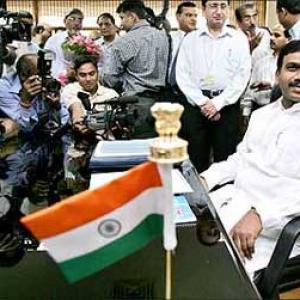When telecom executives went into a meeting with Communications Minister A Raja on Tuesday evening inside the peeling walls of Sanchar Bhawan in New Delhi, they may have believed that things were so bad they could not get any worse.
 They were wrong. The highlight of the meeting was Raja asking mobile telephony operators to reduce termination charges, the money that an operator pays another to whose network the call is made.
They were wrong. The highlight of the meeting was Raja asking mobile telephony operators to reduce termination charges, the money that an operator pays another to whose network the call is made.
"Termination charge is the floor for average pricing in the market. If it goes down, the average price goes down further," said PricewaterhouseCoopers Associate director Arpita Pal Agrawal.
That will only add to the rising clamour that the telecom boom in India is nearing its end. Rising competition (13 licences for each circle), falling tariffs (lowest in the world, falling further because of per-second billing), rapidly declining average revenue per user because the newer subscribers are the low spenders in semi-urban and rural areas, and high taxes (about 30 per cent in all) have put paid to the aspirations of not only the new entrants but also incumbents and pricked the bubble in which everyone thought a licence was the ticket to becoming another Sunil Mittal.
"The year 2007 was a bubble, when people thought that in a boom sector, every individual business must boom. As in any bubble, Indian telecom was seen as a rising tide which would lift every boat. So massive overcapacity got committed, which the market will work out," said Idea Cellular managing director Sanjeev Aga.
In a recent report under the gloomy title of 'Race to the Bottom', Credit Suisse said it foresees "severe margin contraction" and decline in earnings per share of companies.
Ironically, the subscriber growth in the country continues unabated - figures given by the Telecom Regulatory Authority of India, the sector regulator, show that nearly 15 million more users came on board in September. But this has ceased to be a guarantee of good financial health for service providers.
It has also brought into focus the phenomenon of dual SIMs - existing subscribers are acquiring additional connections, resulting in a seeming increase in subscribers but in fact merely leading to a bill being split between two or more service providers.
"Multiple SIM usage is redefining the relationship between the operator and the consumer. You can buy traffic more easily through price cuts, but this is not a foundation to build upon because such traffic can flow away equally easily," said Aga.
The starkest evidence yet that the bubble has been pricked came through the results and forecasts of the three listed companies. First up was Idea Cellular, part of the Aditya Birla group, which reported a 29 per cent sequential drop in profit before tax and exceptional income for the quarter ended September.
The accompanying statement was more of a rant: "The bubble days of 2007-08 had blurred the distinction between the real and the fanciful in the Indian mobile sector. The resultant overcapacity has manifested in tariffs unrelated to economics. Market prices have plumbed depths which predicate that the market itself will eventually work the overcapacity out of the sector."
On cue, HDFC Securities reduced its forecast for Idea's stock price to Rs 44-59 for the next quarter, down sharply from the Rs 71-86 forecast given a month earlier.
"The echo of the statement had barely died down when Bharti Airtel, the largest mobile operator, reported its slowest profit growth in six years and said its growth was going to suffer because of the raging price war. Reliance Communications, in its turn, said its quarterly profit had halved and that there was more pain ahead.
Industry executives, on the condition that they will not be quoted, blamed much of the ills on the government and the regulator. With falling tariffs, they need to cut costs, but their hands are tied because 35-40 per cent of their costs are taxes and other regulatory expenses.
They have to pay 5 per cent of their revenue even from rural areas towards the universal service obligation fund which is meant to promote rural telephony. They said there was no need for the regulator to push for pay-per-second billing by all. This has turned even incumbents into price warriors, leaving little weaponry at the disposal of the new entrants.
As can be expected, the incumbents said they remain committed and focused on growth. "We will continue to enhance our market leadership and simultaneously open new revenue streams like m-commerce, m-entertainment, digital media and many other products. We will continue to focus on higher cost efficiency and productivity so that our cost structure becomes leaner," said Bharti Airtel chief executive officer Manoj Kohli.
Vodafone's resident director, T V Ramachandran, who till the other day was the director-general of the Cellular Operators Association of India, said there was still tremendous scope for growth. "We are bullish."
Idea, which, though it has been in the game for many years, developed national ambitions only three years ago, has adopted a dual strategy. It is restricting itself to tactical cuts in established markets and being aggressive in new ones.
In some circles, it is playing the game by not playing the game. It is curtailing rollout and maximising leverage from other circles, meeting financial objectives by limiting exposure and not competing with the leader across the board.
It is easy to talk of growth when you are an entrenched player, not so when you are a new entrant trying to carve out a slice of the market. For the new ones, the ARPU is said to be in double digits only, as opposed to Rs 230 and more for the established players.
Most of the genuine new subscribers are coming from the rural and semi-urban areas, where the average monthly bill of a user is no more than Rs 60-70. Secondly, an operator has to spend more to net these subscribers.
"The next set coming in is more price-sensitive and lives in difficult territories. You need to cover a larger area to find them and spend more on each for providing service," said PwC's Agrawal.
The result is that most industry players and observers see consolidation clouds on the horizon. "There is a very wide difference in the long-term outlook on profit margin across operators. If the profit margin outlook was in a close cluster, lingering overcapacity was a possibility. But the wide divergence coupled with low tariffs is a deadly combination, which will lead to an early shake-out of excess capacity," said Aga. The consensus is that once the government eases mergers and acquisitions, which it is expected to, a more reasonable lot of five or six operators will be left in each circle.
No wonder, then, that the professional chief executive of a large mobile operator a few days ago went to his boss, the promoter, and said it was time to disregard professional advice. "The important thing is to win the war, not keep the budget in control."






